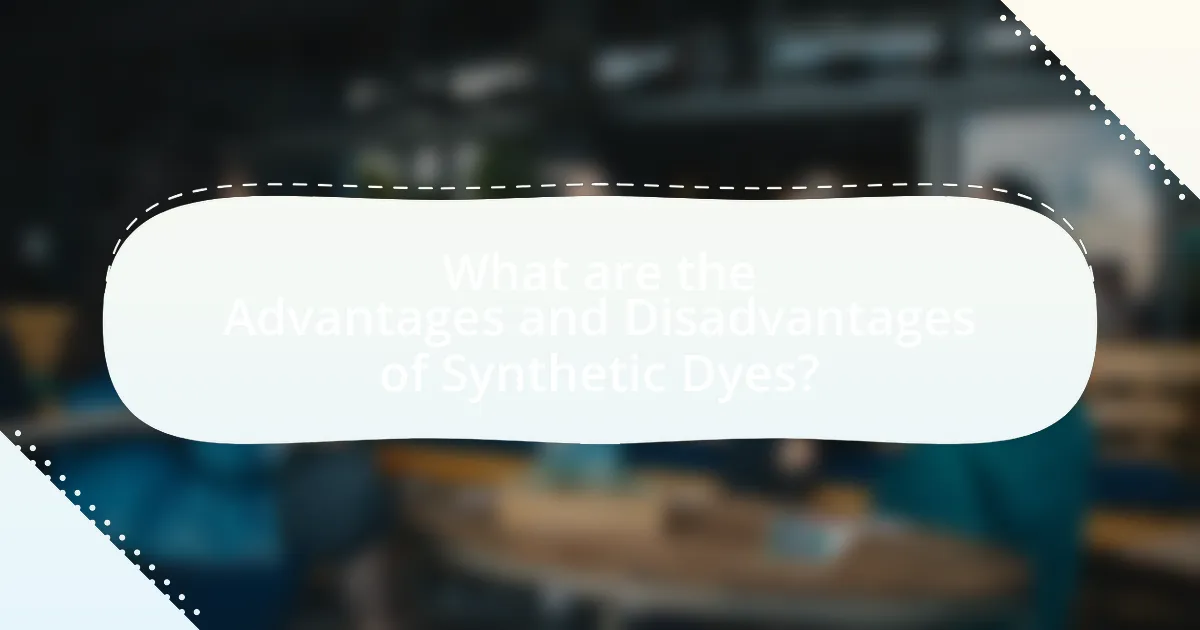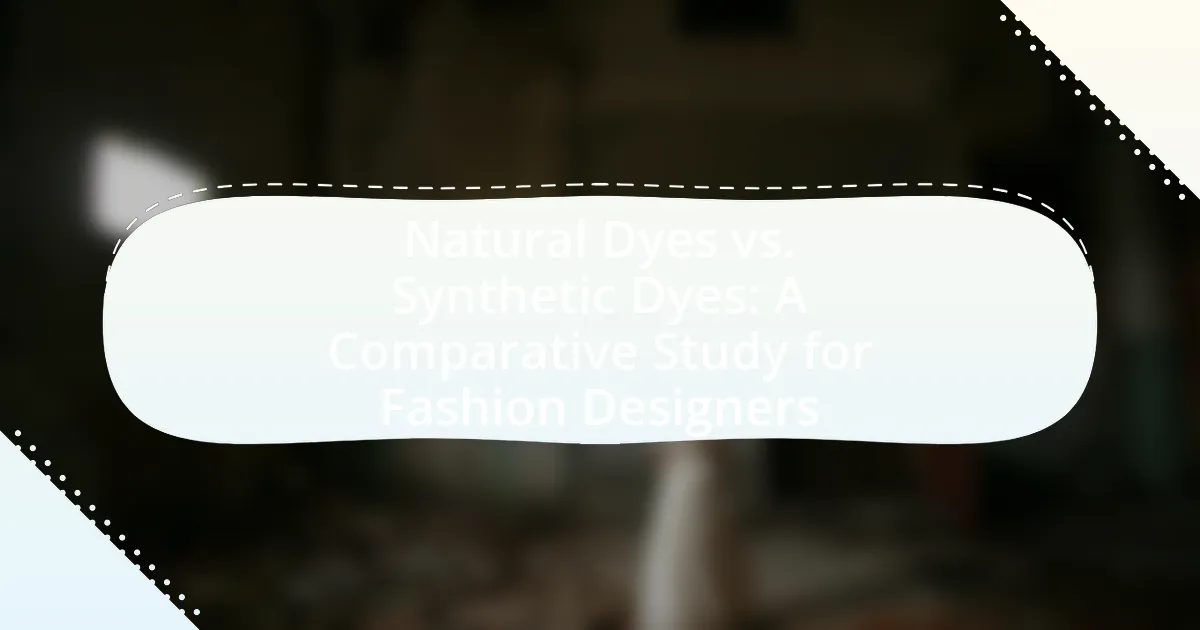The article “Natural Dyes vs. Synthetic Dyes: A Comparative Study for Fashion Designers” examines the distinctions between natural and synthetic dyes, highlighting their origins, environmental impacts, and applications in fashion design. Natural dyes, sourced from plants, minerals, and insects, are biodegradable and eco-friendly, while synthetic dyes, created through chemical processes, offer a wider color range but raise environmental and health concerns. The article discusses the advantages and disadvantages of both types of dyes, including colorfastness, production challenges, and consumer preferences, ultimately guiding designers in making informed choices that balance sustainability with practicality in their work.

What are Natural Dyes and Synthetic Dyes?
Natural dyes are colorants derived from natural sources such as plants, minerals, and insects, while synthetic dyes are artificially created through chemical processes. Natural dyes have been used for thousands of years, with historical evidence showing their application in textiles dating back to ancient civilizations. In contrast, synthetic dyes emerged in the 19th century, offering a broader range of colors and improved colorfastness. The use of natural dyes is often associated with eco-friendliness and sustainability, whereas synthetic dyes can pose environmental concerns due to their chemical composition and potential toxicity.
How do Natural Dyes differ from Synthetic Dyes?
Natural dyes are derived from natural sources such as plants, minerals, and insects, while synthetic dyes are chemically manufactured. The primary difference lies in their origin; natural dyes are biodegradable and often less harmful to the environment, whereas synthetic dyes can contain toxic chemicals and may contribute to pollution. For instance, natural dyes like indigo and madder have been used for centuries and are known for their eco-friendly properties, while synthetic dyes, such as azo dyes, have been linked to health risks and environmental issues due to their chemical composition.
What sources are used for Natural Dyes?
Natural dyes are sourced from various natural materials, including plants, minerals, and insects. Plant sources include roots, leaves, flowers, and fruits, such as indigo from the indigo plant, madder root for red hues, and turmeric for yellow. Mineral sources involve earth pigments like ochre, while insect sources include cochineal, which produces vibrant reds. These sources have been historically used for centuries, with evidence of plant-based dyes dating back to ancient civilizations, demonstrating their long-standing significance in textile coloration.
What chemicals are involved in Synthetic Dyes?
Synthetic dyes primarily involve chemicals such as azo compounds, anthraquinones, and phthalocyanines. Azo compounds, which contain the azo group (-N=N-), are the most widely used synthetic dyes, accounting for approximately 70% of all dyes produced. Anthraquinones are known for their vibrant colors and stability, while phthalocyanines are used for their intense blue and green hues. These chemicals are synthesized through various chemical processes, including diazotization and coupling reactions, which allow for the creation of a wide range of colors and properties in textiles.
Why are Natural Dyes gaining popularity in fashion design?
Natural dyes are gaining popularity in fashion design due to their eco-friendliness and sustainable sourcing. As consumers become more environmentally conscious, the demand for sustainable materials has increased, leading designers to explore natural dyes derived from plants, minerals, and insects. According to a report by the Global Fashion Agenda, 66% of consumers consider sustainability when making a purchase, which drives brands to adopt natural dyeing methods that minimize environmental impact compared to synthetic dyes, which often involve harmful chemicals. This shift not only aligns with consumer values but also promotes biodiversity and supports local economies through the use of indigenous dyeing practices.
What environmental benefits do Natural Dyes provide?
Natural dyes provide significant environmental benefits by being biodegradable and reducing pollution. Unlike synthetic dyes, which often contain harmful chemicals that can contaminate water sources, natural dyes are derived from plants, minerals, and insects, making them less toxic. Studies indicate that the production of natural dyes typically requires less water and energy compared to synthetic alternatives, further minimizing their ecological footprint. Additionally, the cultivation of dye plants can promote biodiversity and sustainable agricultural practices, contributing positively to ecosystems.
How do consumer preferences influence the use of Natural Dyes?
Consumer preferences significantly influence the use of natural dyes by driving demand for sustainable and eco-friendly products. As consumers become more environmentally conscious, they increasingly favor textiles dyed with natural substances over synthetic alternatives, which are often associated with harmful chemicals and environmental degradation. This shift is evidenced by a growing market trend; for instance, a report from Grand View Research indicates that the global natural dyes market is projected to reach $3.5 billion by 2025, reflecting a compound annual growth rate of 5.5%. This preference not only encourages fashion designers to adopt natural dyes but also promotes innovation in sourcing and application methods, as brands seek to meet consumer expectations for sustainability and ethical production.

What are the Advantages and Disadvantages of Natural Dyes?
Natural dyes offer several advantages, including being biodegradable, non-toxic, and derived from renewable resources, which makes them environmentally friendly. They often produce unique and rich colors that can vary based on the source material and application method. However, natural dyes also have disadvantages, such as limited colorfastness, which can lead to fading over time, and a more complex dyeing process that may require specific conditions and expertise. Additionally, the availability of certain natural dye sources can be inconsistent, impacting production scalability.
What are the key benefits of using Natural Dyes in fashion?
Natural dyes offer several key benefits in fashion, including environmental sustainability, safety for human health, and unique aesthetic qualities. The use of natural dyes reduces reliance on synthetic chemicals, which can be harmful to ecosystems and contribute to pollution. For instance, natural dyes are biodegradable and derived from renewable resources, such as plants and minerals, making them a more eco-friendly option. Additionally, natural dyes are less likely to cause allergic reactions or skin irritations compared to synthetic dyes, which often contain toxic substances. Furthermore, natural dyes provide a distinct color palette and depth that can enhance the visual appeal of garments, as each dye can produce varying shades depending on the material and dyeing process. This uniqueness is often sought after in the fashion industry, where individuality and craftsmanship are valued.
How do Natural Dyes impact fabric quality?
Natural dyes enhance fabric quality by providing vibrant colors and improving the overall texture of the material. Unlike synthetic dyes, which can lead to stiffness and a less breathable fabric, natural dyes often result in softer, more supple textiles. Research indicates that fabrics dyed with natural substances, such as indigo or madder, exhibit better moisture absorption and breathability, contributing to comfort and wearability. Additionally, natural dyes can offer improved colorfastness under certain conditions, as evidenced by studies showing that natural dyes can maintain their hue over time when properly applied.
What are the limitations of Natural Dyes in terms of colorfastness?
Natural dyes exhibit significant limitations in colorfastness, primarily due to their susceptibility to fading when exposed to light, washing, and environmental conditions. Unlike synthetic dyes, which are engineered for durability, natural dyes often lack the chemical stability required to maintain vibrant colors over time. Research indicates that natural dyes can fade rapidly, with studies showing that certain natural colors can lose up to 50% of their intensity after just a few washes. Additionally, factors such as pH levels, temperature, and the presence of minerals in water can further compromise the colorfastness of natural dyes, making them less reliable for long-term use in fashion design compared to synthetic alternatives.
What challenges do designers face when using Natural Dyes?
Designers face several challenges when using natural dyes, primarily related to color consistency, availability of materials, and environmental factors. Natural dyes often yield unpredictable color results due to variations in plant sources, extraction methods, and the substrate used, making it difficult for designers to achieve uniformity across batches. Additionally, the sourcing of natural dye materials can be limited and dependent on seasonal availability, which can disrupt production timelines. Environmental factors, such as pH levels and water quality, also influence the dyeing process, further complicating the ability to replicate colors reliably. These challenges highlight the complexities involved in integrating natural dyes into fashion design.
How does the availability of Natural Dye sources affect production?
The availability of natural dye sources directly influences production by determining the accessibility and cost of materials for dyeing processes. When natural dye sources are abundant, production costs decrease, allowing manufacturers to incorporate these dyes more easily into their products. Conversely, limited availability can lead to higher costs and reduced production efficiency, as companies may need to source dyes from distant locations or invest in alternative solutions. For instance, a study published in the Journal of Cleaner Production highlights that regions with rich biodiversity in plant species can support local dye industries, thereby enhancing production capabilities and sustainability.
What skills are required for working with Natural Dyes?
Working with natural dyes requires skills in plant identification, dye extraction techniques, color theory, and textile knowledge. Plant identification is essential for sourcing the correct materials, as different plants yield different colors. Mastery of dye extraction techniques, such as boiling or soaking, is crucial for achieving desired hues. Understanding color theory helps in mixing and matching colors effectively, while knowledge of textiles ensures compatibility between the dye and the fabric. These skills collectively enable successful application and innovation in the use of natural dyes in fashion design.

What are the Advantages and Disadvantages of Synthetic Dyes?
Synthetic dyes offer several advantages, including a wide range of vibrant colors, consistency in color quality, and cost-effectiveness in production. These dyes can be produced in large quantities and are often more stable and resistant to fading compared to natural dyes. For instance, synthetic dyes can achieve bright hues that are difficult to replicate with natural sources, making them popular in the fashion industry.
However, synthetic dyes also have notable disadvantages, such as potential environmental harm and health risks. Many synthetic dyes are derived from petrochemicals, which can lead to pollution during production and disposal. Additionally, some synthetic dyes contain toxic substances that may cause allergic reactions or other health issues in consumers. Research indicates that certain azo dyes, commonly used in textiles, can release carcinogenic compounds when they break down.
What benefits do Synthetic Dyes offer to fashion designers?
Synthetic dyes provide fashion designers with a wide range of benefits, including vibrant color options, consistency in color application, and cost-effectiveness. These dyes allow designers to achieve bright and diverse color palettes that are often unattainable with natural dyes. Additionally, synthetic dyes offer uniformity in color, ensuring that the same shade can be replicated across different batches of fabric, which is crucial for large-scale production. Furthermore, the production of synthetic dyes is generally less expensive than that of natural dyes, making them a more economical choice for designers looking to manage costs while maintaining quality.
How do Synthetic Dyes ensure color consistency?
Synthetic dyes ensure color consistency through precise chemical formulations and controlled manufacturing processes. These dyes are created using specific chemical compounds that provide uniform color properties, allowing for consistent results across different batches. The use of standardized production techniques, such as temperature control and pH balance, further enhances this consistency. Additionally, synthetic dyes undergo rigorous quality control testing, which includes spectrophotometric analysis to measure color accuracy and reproducibility. This systematic approach ensures that the final product maintains the desired hue and saturation, making synthetic dyes a reliable choice for fashion designers seeking uniformity in their designs.
What are the cost implications of using Synthetic Dyes?
The cost implications of using synthetic dyes include lower production costs compared to natural dyes, but potential long-term environmental and health costs. Synthetic dyes are generally cheaper to produce due to their mass manufacturing processes and availability of raw materials, which can lead to a price reduction of 30-50% in dyeing processes. However, the environmental impact of synthetic dyes, such as water pollution and health risks associated with chemical exposure, can result in significant costs for waste management and regulatory compliance. Studies indicate that the textile industry incurs billions in costs related to environmental remediation and health care due to synthetic dye usage, highlighting the need for a comprehensive evaluation of both immediate and long-term financial implications.
What are the environmental concerns associated with Synthetic Dyes?
Synthetic dyes pose significant environmental concerns primarily due to their toxic chemical composition and the pollution they cause during production and disposal. The manufacturing process often involves hazardous substances that can contaminate water sources, harming aquatic life and ecosystems. For instance, the discharge of untreated wastewater from dyeing facilities can introduce heavy metals and carcinogenic compounds into rivers, leading to biodiversity loss and health risks for communities relying on these water sources. Additionally, synthetic dyes are not biodegradable, resulting in long-term environmental persistence and accumulation in soil and water systems. Studies have shown that approximately 20% of industrial water pollution comes from textile dyeing, highlighting the scale of the issue.
How do Synthetic Dyes affect water pollution?
Synthetic dyes significantly contribute to water pollution by releasing toxic substances into aquatic ecosystems. These dyes often contain heavy metals and other harmful chemicals that can contaminate water sources, leading to detrimental effects on aquatic life and human health. For instance, a study published in the Journal of Hazardous Materials found that textile effluents containing synthetic dyes can reduce oxygen levels in water, harming fish and other organisms. Additionally, the World Health Organization has reported that exposure to certain synthetic dyes can lead to serious health issues, including cancer and reproductive problems. Thus, the use of synthetic dyes poses a substantial risk to both environmental and public health.
What regulations exist regarding the use of Synthetic Dyes?
Regulations regarding the use of synthetic dyes primarily focus on safety and environmental impact. In the United States, the Food and Drug Administration (FDA) regulates synthetic dyes under the Federal Food, Drug, and Cosmetic Act, requiring that dyes used in food, drugs, and cosmetics be approved for safety. The Environmental Protection Agency (EPA) also oversees the use of synthetic dyes under the Toxic Substances Control Act, ensuring that chemicals do not pose unreasonable risks to human health or the environment. In the European Union, synthetic dyes are regulated under REACH (Registration, Evaluation, Authorisation and Restriction of Chemicals), which mandates that manufacturers provide safety data and adhere to strict usage guidelines. These regulations are designed to protect consumers and the environment from potential hazards associated with synthetic dyes.
How can fashion designers choose between Natural and Synthetic Dyes?
Fashion designers can choose between natural and synthetic dyes by evaluating factors such as environmental impact, colorfastness, cost, and desired aesthetic. Natural dyes, derived from plants and minerals, are often more eco-friendly but may have limited color range and lower colorfastness compared to synthetic dyes, which are chemically produced and offer a broader spectrum of vibrant colors and better durability. For instance, a study published in the Journal of Cleaner Production highlights that natural dyes can have a lower carbon footprint, while synthetic dyes can provide consistency and reliability in large-scale production. Designers must weigh these considerations based on their brand values, target market, and production methods to make an informed decision.
What factors should designers consider when selecting dyes?
Designers should consider the dye’s colorfastness, toxicity, environmental impact, and compatibility with fabrics when selecting dyes. Colorfastness ensures that the dye maintains its color over time and through washing, which is crucial for garment longevity. Toxicity is important for the safety of both the workers handling the dyes and the end consumers, as some synthetic dyes contain harmful chemicals. Environmental impact is a significant factor, as natural dyes are often more sustainable and biodegradable compared to synthetic options, which can contribute to pollution. Lastly, compatibility with fabrics affects how well the dye adheres and the final appearance of the material, influencing the overall quality of the finished product.
How can designers balance sustainability with practicality in dye choice?
Designers can balance sustainability with practicality in dye choice by selecting natural dyes that offer both eco-friendliness and functional performance. Natural dyes, derived from plants, minerals, and insects, are biodegradable and less harmful to the environment compared to synthetic dyes, which often contain toxic chemicals. For instance, studies show that natural dyes can achieve vibrant colors and good wash fastness when properly processed, making them practical for various applications in fashion. Additionally, advancements in dyeing techniques, such as mordanting and using sustainable sourcing practices, enhance the effectiveness of natural dyes while maintaining their environmental benefits. This dual focus on sustainability and practicality allows designers to create garments that are both environmentally responsible and commercially viable.
What are best practices for using Natural and Synthetic Dyes in fashion design?
Best practices for using natural and synthetic dyes in fashion design include selecting dyes based on the desired colorfastness, environmental impact, and fabric compatibility. Natural dyes, derived from plants, insects, or minerals, should be chosen for their eco-friendliness and unique color variations, while synthetic dyes offer a broader color palette and consistency. It is essential to conduct pre-testing on fabric samples to ensure the dye adheres properly and achieves the intended shade. Additionally, using mordants with natural dyes can enhance color retention, while following safety guidelines for synthetic dyes is crucial to minimize health risks. Research indicates that natural dyes can have lower environmental impacts, but synthetic dyes often provide greater durability and vibrancy, making informed choices vital for sustainable fashion design.

Leave a Reply